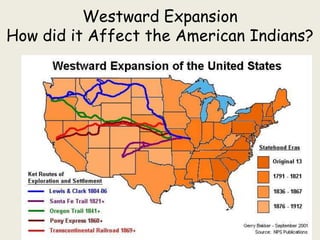
Westward expansion & indians
- 1. Westward Expansion How did it Affect the American Indians?
- 2. 1872 John Gast “Manifest Destiny” “Spirit of the Frontier” What is happening here? How does this represent Americans’ way of thinking at this time?
- 4. Westward Expansion – How did Americans justify westward expansion and the removal of Indian tribes and their right to land? It was rationalized in terms that it would bring Anglo-Saxon institutions into an area that was devoid of such enlightenment. The hypocrisy of this is obvious The argument that was because many of the people, used was, "This had to be though not all of them, who done to save these poor were removed were very Indian people. They don't sophisticated and relatively fit in the East, so we have "civilized" people. For example, to move them out beyond the literacy rate of the Cherokee the frontier where they can nation is higher than that of the do their Indian thing . This white South up through the Civil is the only possible way to War, yet the tribe was moved save them." westward as an uncivilized people, so that their land could be open for American expansion.
- 5. Texas Rangers Guarded the Patrolled the Effects Duties frontier frontier, enabling Mounted on settlers to move horse to cover westward large amounts of Led to increased land conflicts between Used Colt six- American Indians shooter and settlers
- 6. The Reservation Policy • Most Texans wanted a “Separate but equal” policy with the Indians • The Texas legislature set aside approximately 70,000 acres, for Indian reservations in northwest Texas.
- 7. The Reservation Policy • Two major Indian reservations were built: • The Brazos County Indian Reservation – 2000 Indians moved to the reservation, including Caddo, Anadarko, Waco, and Tonkawa. – Many Indians moved to the reservation to gain protection from the Comanche. • The Comanche Indian Reservation was located about forty miles away.
- 8. The Reservation Policy • The Alabama- Coushatta, unique among Texas tribes in their ability to maintain peace with Texans, moved to a ****These people managed to avoid reservation in becoming involved in the warfare that was Polk County. about to engulf their fellow Texas Indians.
- 9. The Removal of Texas Indians By the late 1850s, Conflicts between the most Texans Comanche and Texans considered the made them eager to reservation expel the Indians from experiment to be a Texas permanently. failure. As a result, the U.S. Army and Texas Rangers launched several military offensives against the Comanche.
- 10. Texas Indian Reservations Today • Unlike other western states, Texas has almost no Indian lands due to the conflicts that drove most of the Indians to other states. http://www.laits.utexas.edu/txp_media/html/cult/features/0500_02/indianr eservation.html
- 11. Indian Policy after the Civil War The federal garrisons that were supposed to protect settlers were IT WAS A DIFFICULT undermanned. Texas wanted to provide TIME FOR ALL: rangers to supplement For both groups, the frontier defense but frontier remained was ruined financially by the defeat in the unsafe and war. unpredictable.
- 12. Slaughter of the William T. Sherman, commander of the U.S. Buffalo Army, and Philip H. Sheridan, commander of U.S. troops in Texas, were To this end, veterans of some of the they began a worst fighting of the Civil policy of War. encouraging the slaughter of the southern buffalo herd.
- 13. Slaughter of the Buffalo • Buffalo in Texas were first described by Cabeza de Vaca. Texas was home to four main herds, and at the height of their population, their trails could be several miles wide. What became known as the "great slaughter" took place in the 1870s, and by 1878 the buffalo in Texas was all but exterminated.
Notas del editor
- This painting shows "Manifest Destiny" (the religious belief that the United States should expand from the Atlantic Ocean to the Pacific Ocean in the name of God). In 1872 artist John Gast painted a popular scene of people moving west that captured the view of Americans at the time. Called "Spirit of the Frontier" and widely distributed as an engraving portrayed settlers moving west, guided and protected by a goddess-like figure of Columbia and aided by technology (railways, telegraphs), driving Native Americans and bison into obscurity. It is also important to note that angel is bringing the "light" as witnessed on the eastern side of the painting as she travels towards the "darkened" west. The concept of American expansion is much older, but John L. O'Sullivan coined the exact term "Manifest Destiny" in the July/August 1845 issue of the United States Magazine and Democratic Review in an article titled "Annexation."
- Far from weakening the republic, they argued, territorial growth would actually serve to strengthen it, providing unlimited economic opportunities for future generations.
- There was no money to wage war, and Texans faced a situation that appeared virtually unchanged from two decades before.